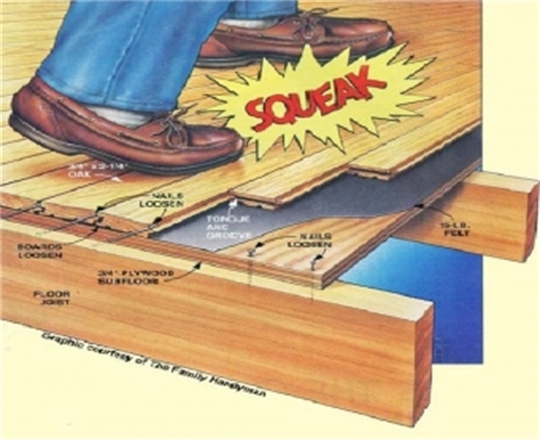Have you ever tiptoed through your home, avoiding every creak and groan of your wood floor, feeling like you’re walking on eggshells? The unsettling symphony of squeaky floorboards can be more than just an annoyance. It can be a constant reminder of a nagging home maintenance issue, and even a source of embarrassment when unexpected guests arrive. But fear not, fellow squeaky-floor sufferers! This comprehensive guide will arm you with the knowledge and tools to conquer those troublesome floorboards and reclaim the peace and quiet of your home.

Image: www.china-floor-inspection.com
A squeaky wood floor is a common problem, particularly in older homes, and it usually occurs when the wood subfloor and floorboards separate, allowing friction to occur when you walk on them. Knowing the cause can help you determine the best approach to silencing those annoying sounds. So let’s dive in and explore the world of squeaky wood floors, learning how to identify the cause and effectively solve the problem.
Understanding the “Whys” of Squeaky Floors
Before you launch into a full-scale renovation of your floors, it’s crucial to understand the root cause of the squeaks. Why are those floorboards suddenly making so much noise? Here are some of the common culprits:
- Loose Floorboards: Over time, the nails or screws holding down the floorboards can work loose, allowing the boards to shift and rub against the subfloor, creating that unmistakable squeak.
- Wear and Tear: Years of foot traffic take their toll on the finish of floorboards, making them thinner and more prone to squeaking.
- Shifting Foundations: If your foundation is settling or shifting, it could put stress on your subfloor, leading to floorboard separation.
- Moisture and Humidity: Changes in moisture levels can cause wood to expand and contract, affecting the tightness of the floorboards.
Silencing the Squeaks: A Toolkit of Solutions
Now that we understand the sources of squeaky floors, let’s explore various methods for tackling them, from the simplest fixes to more involved repairs.
1. DIY Solutions for Squeaky Floors:
- Screwing it Down: This is often the most effective and easiest solution. Using a drill with a screwdriver bit, carefully screw down any loose floorboards directly into the subfloor. A few strategically placed screws can dramatically reduce squeaking.
- Adding Shims: For gaps between floorboards and the subfloor, you can use wooden shims to fill in the space. Use wood glue or construction adhesive to secure the shims in place.
- Talcum Powder or Baby Powder: If you’re reluctant to use screws or shims, try sprinkling talcum powder or baby powder between the floorboards. The powder will act as a lubricant to reduce friction.

Image: www.youtube.com
2. The “Sneaky” Method – Tackling Squeaks From Below:
For those who prefer a less intrusive solution, consider addressing the squeaks from underneath the floor. This approach often requires access to your crawlspace or basement:
- Apply Construction Adhesive: For squeaky floorboards, applying construction adhesive to the underside of the floorboards can help secure them to the subfloor.
- Use Wood Glue: If the subfloor is accessible, try using wood glue to bond the gaps between the floorboards and the subfloor.
3. The “Heavy Lifting” Method – Re-fastening Floating Floors:
If your floorboards are part of a “floating” floor system, which isn’t directly attached to the subfloor, a different approach is needed:
- Locate the Fasteners: Floating floors often have a “tongue and groove” system. Find the hidden fasteners along the edges of each plank.
- Tighten the Fasteners: Use a special floor-nailing tool to tighten or re-fasten the fasteners to secure the floorboards to the underlying support system.
- Consider Professional Help: For more complex situations, it’s advisable to consult a professional floor installer or carpenter.
Expert Advice for a Quieter Home
While DIY solutions often work wonders, sometimes the squeaky floor problem requires a more comprehensive approach. Consulting a professional can provide insights into the long-term solutions for your situation.
- Hiring a Floor Specialist: If your squeaks are persistent and the DIY methods aren’t effective, consider hiring a flooring specialist. They’ll be able to assess the problem from a professional perspective, recommending the best solutions, including replacing floorboards or addressing underlying structural issues.
- Prioritize Prevention: It’s always a good idea to maintain your floors proactively to avoid future squeaking woes. Regularly inspect your floorboards for any movement or looseness, and address them promptly as they occur.
How To Stop A Squeaky Wood Floor
Silencing the Squeaks, Reclaiming the Silence
With patience, a little effort, and the right tools, you can silence those pesky squeaks and enjoy a quieter, more peaceful home. From simple DIY solutions to expert guidance, there’s a path to achieving a squeak-free floor that suits your needs and budget. Remember, a well-maintained floor is a happy floor, and your home will thank you for it.






